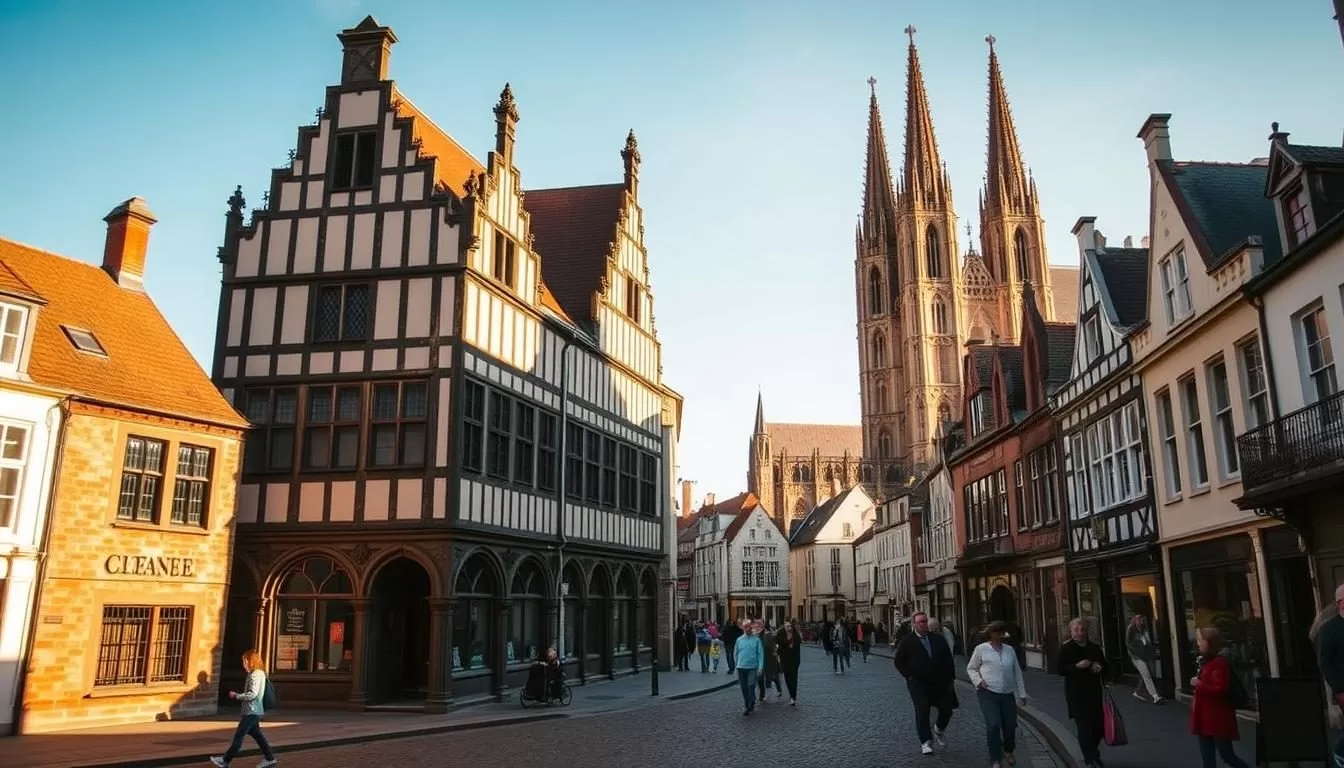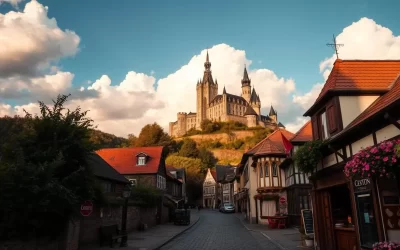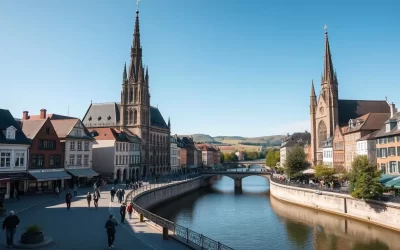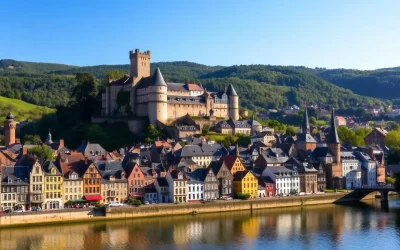Are you ready to explore a town steeped in history and rich in cultural heritage? Ieper, commonly known as Ypres, is a must-visit destination in Belgium’s West Flanders province. This charming town has a significant place in the world‘s history, particularly due to its role in World War I.
As you wander through the town, you’ll discover a blend of historical landmarks and quaint attractions. The town’s history is palpable, from the poignant memorials to the meticulously reconstructed architecture. You’ll find that things to see and do are plentiful, catering to history buffs, families, and architecture enthusiasts alike.
From the In Flanders Fields Museum to the Menin Gate Memorial, and the moving Last Post Ceremony, you’ll experience the depth of history that this town has to offer. Get ready to immerse yourself in the authentic culinary experiences and practical travel information that will make your visit truly unforgettable.
Discovering Ypres: A Historical Gem in Flanders
Nestled in the heart of Flanders, Ypres is a town that seamlessly weaves its rich history into the fabric of daily life. As you wander through its streets, you’ll discover a blend of somber war memorials, medieval architecture, and modern amenities that make Ypres a unique destination.
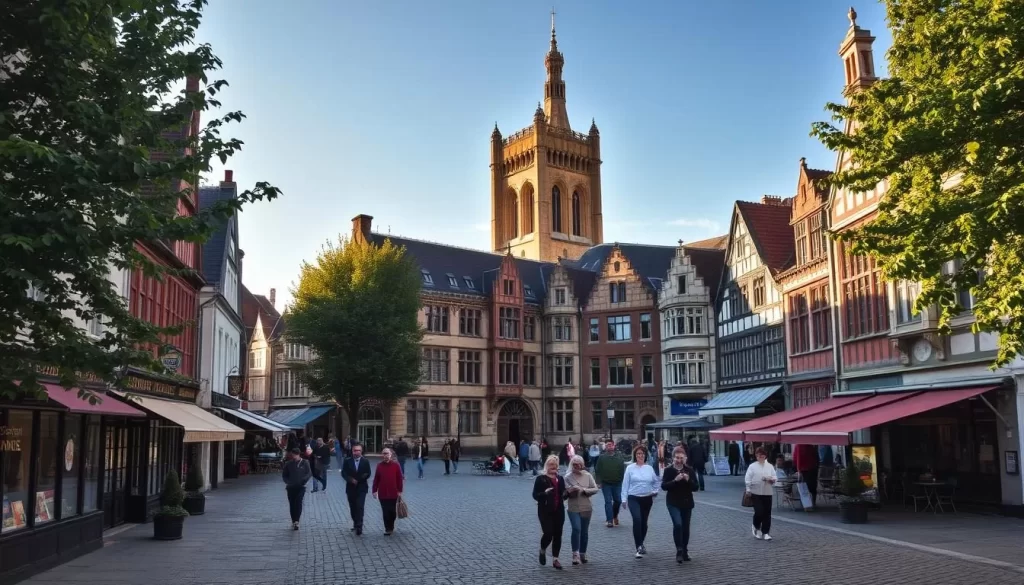
A Brief History of Ypres
Ypres has a storied past, having been a significant location during World War I. The town was a focal point of several major battles, including the Battle of Ypres, which left it heavily damaged. Despite the devastation, Ypres has been meticulously reconstructed to retain its historical charm. Today, visitors can explore the sights that reflect its medieval past, alongside poignant reminders of its role in the war.
The history of Ypres dates back to the 10th century when it became known for its textile industry, particularly wool. This prosperity continued through the medieval period, during which the town was fortified and significant buildings like the Cloth Hall were constructed. Understanding this history provides context to the resilient spirit of Ypres and its people.
Why Ypres Should Be on Your Belgium Itinerary
Ypres offers a plenty of experiences that cater to various interests. For history enthusiasts, the town provides an intimate connection to World War I through its preserved sites and daily commemorations. The reconstructed medieval town center, with its impressive architecture, offers a charming atmosphere that is hard to find in more touristy cities.
Visitors can enjoy a range of things to do, from exploring war memorials and museums to savoring Belgian cuisine and relaxing in the town’s welcoming ambiance. Whether you’re traveling solo, with family, or in a group, Ypres has something to offer, making it an ideal addition to any Belgium itinerary.
By visiting Ypres, you’ll gain a deeper understanding of Belgian history and culture, experiencing firsthand the blend of historical significance and modern hospitality that defines this remarkable town.
The Historical Significance of Ypres in World War I
As you explore Ypres, you uncover the profound impact of the First World War on this Belgian town. Ypres is a place where history comes alive, and its significance in World War I is still palpable today.
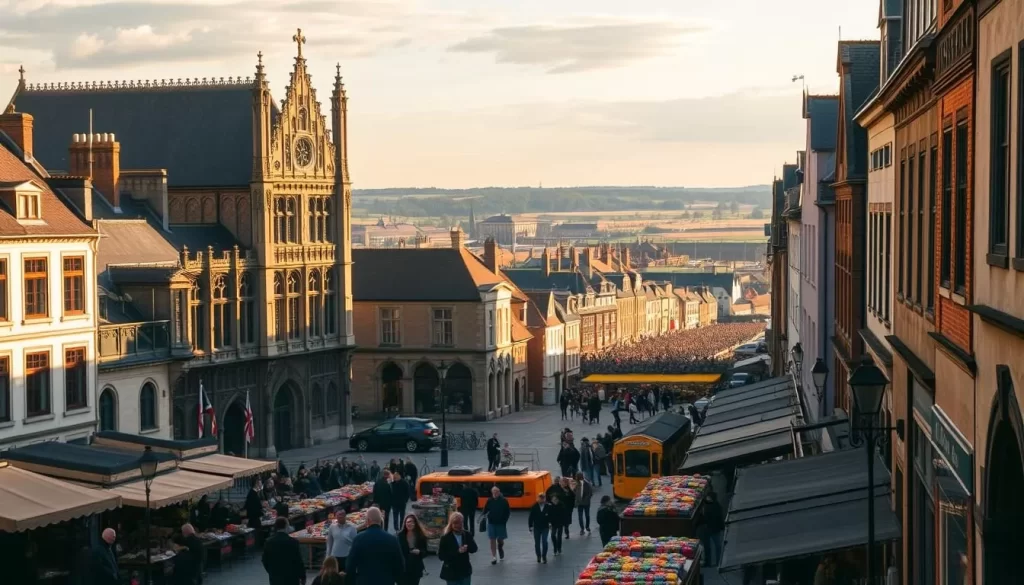
The Ypres Salient and Major Battles
The Ypres Salient was a critical location during World War I, witnessing some of the war’s most brutal battles. The First Battle of Ypres in 1914 marked the beginning of a prolonged and bloody conflict that would see the town become a symbol of sacrifice and loss.
- The First Battle of Ypres (1914) was the initial confrontation, setting the stage for subsequent battles.
- The Second Battle of Ypres (1915) saw the introduction of chemical warfare, leaving a lasting impact on the town and its people.
- The Third Battle of Ypres (1917), also known as the Battle of Passchendaele, was characterized by its muddy, bloody conditions and massive losses on both sides.
These battles, fought in and around Ypres, were pivotal in the larger narrative of World War I, and their legacy continues to be felt today.
The Destruction and Reconstruction of the City
During the war, the town centre of Ypres was entirely destroyed, reduced to rubble by relentless artillery bombardment. The main market square, Grote Markt, and most of the important buildings were left in ruins.
The reconstruction of Ypres was a painstaking process that began in the 1920s. Using old photographs and architectural plans, the city was rebuilt to its original 14th-century medieval style. The rebuilt Cloth Hall and St. Martin’s Cathedral stand as testaments to the town’s resilience and its commitment to preserving its historical heritage.
Key aspects of the reconstruction include:
- The careful rebuilding of historical buildings, such as the Cloth Hall and the cathedral.
- The use of original plans and photographs to ensure authenticity.
- The preservation of the town’s medieval character, despite the devastation of war.
Today, visitors to Ypres can experience a faithful recreation of the medieval town while still acknowledging its wartime destruction. The historical significance of Ypres in World War I is a powerful reminder of the past, preserved for future generations.
In Flanders Fields Museum
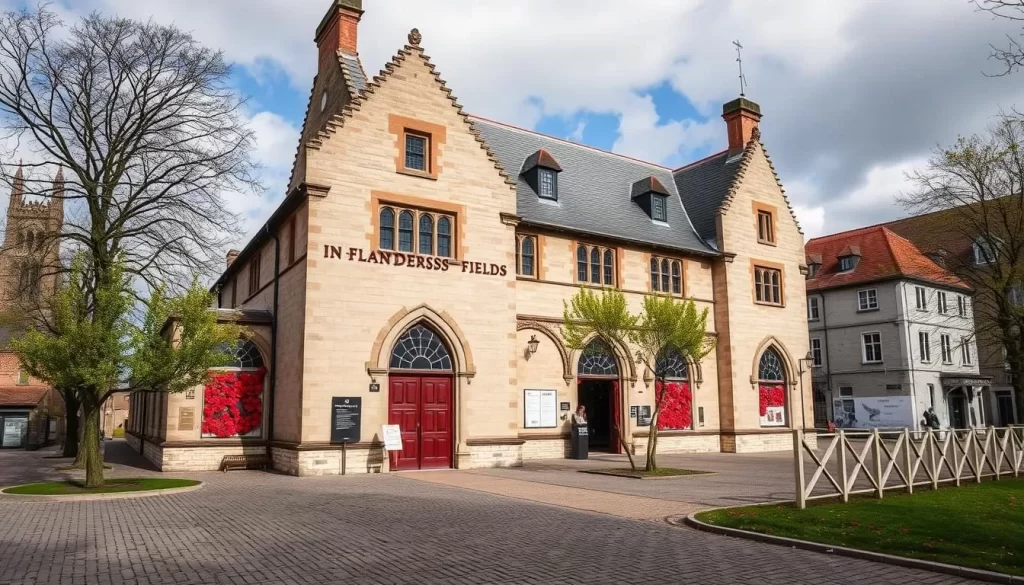
The In Flanders Fields Museum, situated in the heart of Ypres, offers a poignant and immersive experience into the history of World War I. Located on the second floor of the Cloth Hall (Lakenhalle) in the main town square, this museum is a significant landmark that pays tribute to the soldiers who fought and lost their lives during the Great War.
Interactive Exhibits and Collections
As you explore the museum, you’ll encounter a vast array of artifacts, personal stories, and interactive exhibits that bring the history of World War I to life. The museum’s collection includes uniforms, weapons, and personal belongings of soldiers, as well as poignant reminders of the devastating consequences of war. With the help of modern technology, the exhibits create an immersive experience, allowing you to understand the harsh realities of life in the trenches.
The museum’s interactive displays and personal stories make it an engaging experience for visitors of all ages. You’ll have the opportunity to explore the trenches, learn about the daily life of soldiers, and understand the historical context of the war. The museum’s curators have carefully crafted the exhibits to provide a nuanced and balanced perspective on this pivotal moment in history.
Practical Visitor Information
Before planning your visit to the In Flanders Fields Museum, it’s essential to know the practical details. The museum is open throughout the year, with opening hours varying by season. From April to September, the museum is open from 10 AM to 6 PM, while from October to March, it operates from 10 AM to 5 PM. You can spend a day exploring the museum and its surroundings, taking in the historical significance of the area.
Admission prices are structured to accommodate different visitor groups, with special rates available for students, seniors, and families. To make the most of your visit, consider using the audio guides available in multiple languages, which provide in-depth commentary on the exhibits. Most visitors allocate 2-3 hours to explore the museum, but you may want to plan for more time to absorb the rich history on display. The museum is located in the town centre, making it easily accessible and within walking distance of other key attractions in Ypres.
The Menin Gate Memorial

The Menin Gate Memorial, located in Ypres, Belgium, stands as a powerful reminder of the sacrifices made during the First World War. This monumental structure is dedicated to the memory of soldiers who lost their lives in the region. As you approach the memorial, you are met with an imposing architecture that commands respect and reflection.
History and Architecture of the Memorial
The Menin Gate Memorial was designed by Sir Reginald Blomfield and unveiled in 1927. It is one of the most significant memorials to the missing soldiers of World War I. The memorial is an impressive example of early 20th-century monumental architecture, with its large stone structure and imposing arches. As you walk through the memorial, you notice the intricate details and the solemn atmosphere it creates.
The memorial honors the memory of over 55,000 soldiers who have no known grave. Their names are inscribed on the panels of the memorial, a poignant reminder of the vast number of casualties during the war. The Menin Gate Memorial is not just a monument; it is a place of remembrance and reflection, where visitors can pay their respects to those who made the ultimate sacrifice.
The significance of the phrase “Their name liveth for evermore” inscribed on the memorial is a message of hope and remembrance. It serves as a reminder that even though these soldiers may have lost their lives, their memory and sacrifice will live on.
Finding Names on the Memorial
Navigating the Menin Gate Memorial can be a moving experience, especially when looking for specific names among the many inscribed on its panels. The names are organized by regiment and rank, making it a systematic yet emotional task to locate a particular soldier. Visitors can use the registry books available at the site to help locate specific names. Additionally, helpful attendants are on hand to assist in finding names, making the process less daunting.
The Commonwealth War Graves Commission’s online database is another valuable resource for those researching soldiers before their visit. This database allows you to search for names and learn more about the soldiers commemorated on the memorial. By researching beforehand, you can gain a deeper understanding of the personal stories behind some of the names, including brothers who died together and the youngest soldiers commemorated.
As you explore the memorial, you are not just viewing a historical monument; you are connecting with the personal stories and sacrifices of those who are remembered here. The Menin Gate Memorial is a powerful tribute to the soldiers who lost their lives, and by understanding its history and significance, you can appreciate the depth of the sacrifice made.
The Last Post Ceremony at Menin Gate
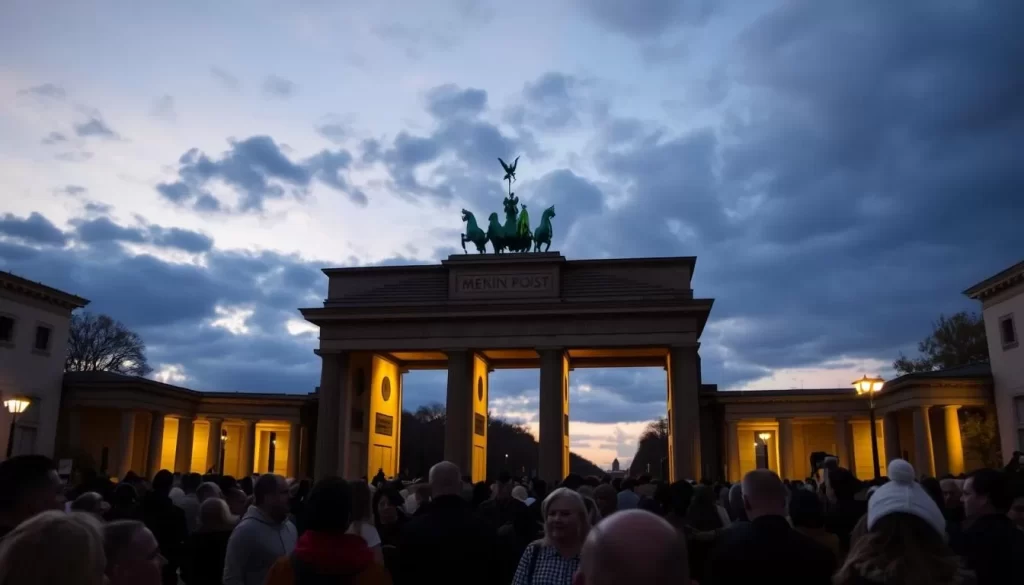
Every night, at 8 PM, the Menin Gate in Ypres, Belgium, hosts a poignant ceremony known as the Last Post. This ceremony is a tribute to the soldiers who lost their lives during World War I. The Menin Gate Memorial, a significant historical landmark, serves as the backdrop for this daily tribute. As you plan your visit to Ypres, attending the Last Post Ceremony is a must to understand the city’s deep-rooted history and its connection to the Great War.
The Tradition and Its Significance
The Last Post Ceremony has been a tradition since 1928, making it a longstanding tribute to the fallen soldiers. It is performed by the Last Post Association, with buglers from the Fire Service or local veterans’ organizations participating. The ceremony involves the sounding of the Last Post, a bugle call associated with military funerals and remembrance services. This solemn ceremony is a reminder of the sacrifices made during the war and honors the memory of those who were lost.
The significance of the Last Post Ceremony extends beyond the ceremony itself; it represents a continued acknowledgment of the historical events that shaped Ypres and the world. By attending the ceremony, you become part of a larger community that respects and remembers the past.
Tips for Attending the Ceremony
To make the most of your experience at the Last Post Ceremony, plan to arrive at least 30-45 minutes before the 8 PM ceremony. This is especially important during peak travel seasons or on significant dates like Anzac Day (April 25) and Armistice Day (November 11), when the ceremony attracts larger crowds.
- Arrive early to secure a good viewing position.
- Be mindful of the etiquette during the ceremony; maintain respectful silence and follow photography guidelines.
- Choose a viewing spot that is suitable for your group, especially if you’re traveling with children or individuals with mobility issues.
- Be prepared for varying weather conditions, as the ceremony takes place outdoors.
By following these tips and understanding the significance of the Last Post Ceremony, you can have a meaningful and respectful experience during your visit to Ypres.
Exploring the Grote Markt (Market Square)
As you step into the heart of Ypres, the Grote Markt unfolds its charm, a testament to the city’s rich history and vibrant culture. This historic square is the perfect place to experience the essence of Ypres, surrounded by stunning architecture, a variety of shops, and an array of dining options.
The Impressive Cloth Hall (Lakenhalle)
The Grote Markt is dominated by the imposing Cloth Hall, or Lakenhalle, a magnificent structure that stands as a testament to Ypres’ medieval prosperity. This impressive building, with its striking architecture, now houses the In Flanders Fields Museum, although the Cloth Hall itself is worth visiting for its historical significance and architectural beauty. As you explore the Cloth Hall, you are surrounded by the history of Ypres, from its origins as a thriving textile center to its role in World War I.
The Cloth Hall’s architecture is a highlight of the Grote Markt, offering a glimpse into the city’s rich past. Its grandeur and the stories it holds make it a compelling visit for anyone interested in history and architecture.
Shops, Restaurants, and Seasonal Events
Surrounding the Grote Markt, you’ll find a plenty of shops, ranging from boutiques selling local crafts to chocolate shops offering Belgian specialties. Whether you’re looking for unique souvenirs or simply want to indulge in some retail therapy, the Grote Markt has something for everyone. You can also enjoy traditional Flemish cuisine at one of the many restaurants or cafés, taking in the views of the historic square.
The Grote Markt is not just a static historical site; it’s a vibrant public space that hosts various events throughout the year. During the festive months, the square transforms with the setup of an ice rink, Christmas markets, and fun rides, creating a lively atmosphere that attracts visitors from all over. You can also explore the weekly markets where locals sell fresh produce, flowers, and artisanal products, adding to the square’s dynamic charm.
Visiting the Grote Markt is an experience that combines history, culture, and entertainment, making it a must-visit destination in Ypres. With its grote markt at the heart of the city, Ypres offers a unique blend of the past and present, ensuring that your visit is both memorable and enjoyable.
St. Martin’s Cathedral
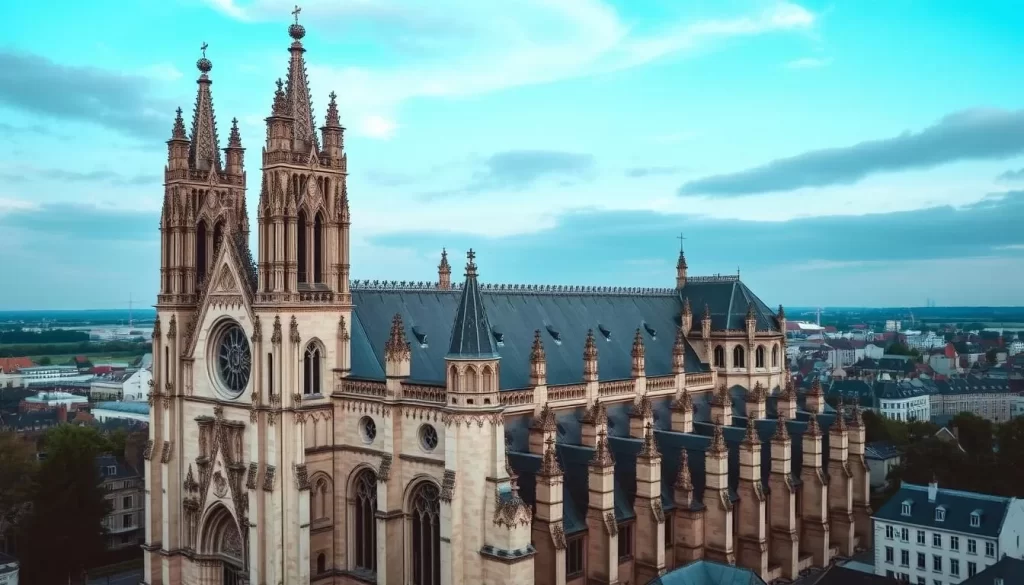
As one of the tallest structures in the region, St. Martin’s Cathedral in Ypres is a must-visit attraction for history buffs and architecture enthusiasts alike. Wherever you are in the city, you can’t miss the sight of the cathedral. It’s one of the tallest buildings in the country!
Architecture and History
St. Martin’s Cathedral is a significant historical and architectural landmark in Ypres. The cathedral’s history dates back several centuries, with its construction beginning in the 13th century. Over the years, it has undergone various transformations and restorations, particularly after suffering damage during World War I.
The cathedral’s architecture is a blend of different styles, reflecting the various periods of its construction and renovation. Visitors can admire its beautiful stained glass windows and the ornate wooden pulpit, among other notable features.
Visitor Information
When planning your visit to St. Martin’s Cathedral, it’s useful to know that it is typically open daily from 9 AM to 5 PM. Visitors can explore the cathedral on their own or opt for guided tours that provide in-depth information about its history, architecture, and religious significance.
The cathedral remains an active place of worship with regular services, adding a layer of contemporary religious life to its historical significance. For photographers, the cathedral offers numerous opportunities to capture its grandeur, with the best times usually early morning or late afternoon.
Battlefield Tours Around Ypres
Embark on a poignant journey through the Flanders Fields with guided battlefield tours around Ypres, a poignant reminder of the region’s complex history. The Ypres Salient, a site of great historical significance, is best explored with knowledgeable guides who can provide context and insights into the events that unfolded during World War I.
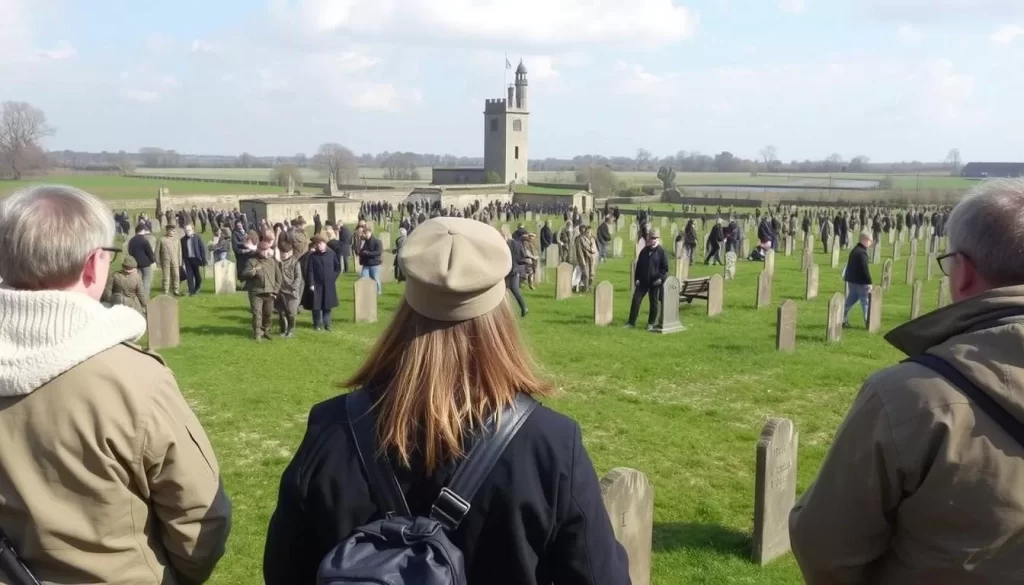
Popular Tour Options and Operators
Several tour operators offer guided battlefield tours around Ypres, each providing a unique perspective on the region’s history. These tours typically last several hours, giving you ample time to absorb the atmosphere and learn about the significant sites.
Some popular tour options include visits to preserved trenches, bunkers, craters, and cemeteries, such as Hill60, Essex Farm Cemetery, and Tyne Cot Cemetery. These sites offer a glimpse into the harsh realities of war and the sacrifices made by soldiers during World War I.
When choosing a tour operator, consider factors such as the guide’s expertise, the tour’s duration, and the sites included in the itinerary. This will help ensure that your experience is both informative and memorable.
What to Expect on a Battlefield Tour
On a typical battlefield tour around Ypres, you can expect to visit several significant sites, including preserved trenches, bunkers, and cemeteries. Your knowledgeable guide will provide historical context and personal stories, connecting you to the human experience of war.
To make the most of your tour, be sure to wear comfortable walking shoes and dress according to the weather. Bringing a camera is also recommended, as you’ll want to capture the poignant landscapes and memorials.
As you explore the Ypres Salient, you’ll gain a deeper understanding of the region’s history and the significance of the sites you visit. The preserved landscapes serve as a living memorial to those who fought and died there, making for a truly emotional and thought-provoking experience.
Ypres, Belgium: Best Things to Do for History Buffs
For history enthusiasts, Ypres, Belgium, is a treasure trove of World War I sites and experiences. The city’s historical significance is palpable as you walk through its streets and visit its numerous historical sites. Ypres offers a unique blend of preserved trenches, bunkers, and lesser-known historical gems that provide a comprehensive understanding of the area’s role in the First World War.
Exploring Preserved Trenches and Bunkers
One of the most compelling aspects of visiting Ypres is the opportunity to explore the original trenches and bunkers of World War I. These sites offer a poignant glimpse into the harsh realities faced by soldiers during the war. You can walk through the trenches, seeing firsthand the conditions that soldiers endured, and visit bunkers that have been preserved to varying degrees.
Key Sites to Visit:
- The Tyne Cot Trenches, part of the larger Tyne Cot Cemetery, one of the largest Commonwealth war cemeteries in the world.
- The Bayonet Trench, a preserved trench system that gives visitors a stark insight into life in the trenches.
- Various Bunker Sites scattered around the Ypres Salient, some of which have been restored and are open to visitors.
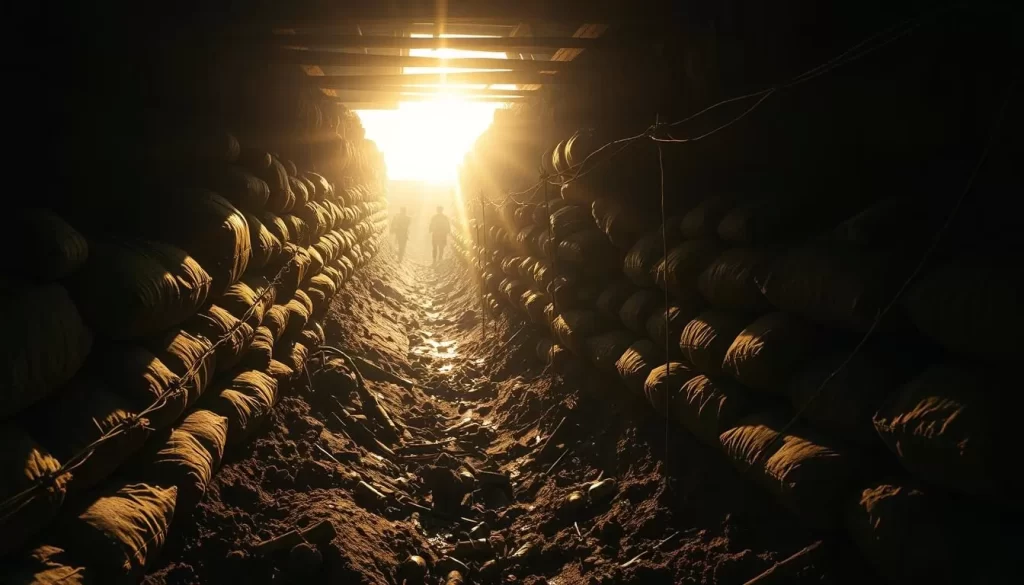
Visiting these trenches and bunkers is a sobering experience, providing a tangible connection to the past. It’s a chance to understand the strategic and tactical aspects of the war, as well as the human cost.
| Site | Location | Features |
|---|---|---|
| Tyne Cot Trenches | Near Tyne Cot Cemetery | Preserved trench system, Commonwealth cemetery |
| Bayonet Trench | Near Zonnebeke | Well-preserved trench, educational signage |
| Various Bunkers | Scattered around Ypres Salient | Restored bunkers, historical significance |
Lesser-Known Historical Sites
Beyond the major memorials and museums, Ypres and its surroundings are dotted with lesser-known historical sites that offer a more nuanced understanding of the First World War. These sites provide insights into various aspects of the conflict, from the daily lives of soldiers to the broader strategic context.
Notable Sites:
- Talbot House in nearby Poperinge, a former soldiers’ club that offered respite from the front lines.
- Essex Farm Cemetery and Dressing Station, where John McCrae wrote the famous poem “In Flanders Fields.”
- The Pool of Peace (Spanbroekmolen Crater), a massive mine crater now filled with water and preserved as a memorial.
- German Cemetery at Langemark, offering a different perspective on the conflict and remembrance.
These sites collectively enhance your understanding of the war’s impact and the experiences of those involved. They offer a chance to reflect on the conflict from multiple perspectives, fostering a deeper appreciation of this pivotal moment in history.
War Cemeteries and Memorials
As you explore Ypres, you’ll discover a multitude of war cemeteries and memorials that honor the memory of soldiers from different nations. These sites are a poignant reminder of the sacrifices made during the First World War.
Tyne Cot Cemetery

One of the most significant sites to visit is the Tyne Cot Memorial and Cemetery, a must-do even if you’re not taking a guided tour. This area on the Western Front was the scene of the Third Battle of Ypres, also known as the Battle of Passchendaele, one of the major battles of the First World War. The memorial is the largest Commonwealth war grave in the world and is very moving to walk through. It bears the names of 35,000 men of the British and New Zealand forces, nearly all of whom died between August 1917 and November 1918.
The Tyne Cot Cemetery is a sobering experience, with rows of headstones stretching as far as the eye can see. It’s a powerful reminder of the scale of loss during the war. As you walk through the cemetery, take a moment to reflect on the lives lost and the historical significance of this site.
Other Significant Memorials in the Area
Beyond Tyne Cot, the Ypres Salient is home to numerous other memorials and cemeteries, each with its own unique story to tell. You can explore the Island of Ireland Peace Park, a memorial to the soldiers from Ireland who fought and died in World War I. The Brooding Soldier Canadian Memorial at Vancouver Corner is another poignant site, commemorating the victims of one of the first gas attacks.
- Visit Essex Farm Cemetery, where John McCrae wrote “In Flanders Fields” and which contains the grave of Valentine Joe Strudwick, one of the youngest soldiers killed in the war.
- Learn about Lijssenthoek Military Cemetery, the second-largest Commonwealth cemetery in Belgium, located at what was a major evacuation hospital during the war.
These various memorials collectively tell the story of different nations, units, and individuals who fought and died in the Ypres Salient. As you explore these sites, you’ll gain a deeper understanding of the history and significance of the area and the soldiers who lost their lives.
Family-Friendly Activities in and Around Ypres
Beyond its historical significance, Ypres is a great place for families to explore and learn together. The city and its surroundings offer a variety of activities that cater to all ages, ensuring a fun and memorable trip for everyone.
Bellewaerde Theme Park
Bellewaerde Theme Park is a must-visit attraction for families traveling to Ypres. As one of the most popular theme parks in Belgium, it offers an exciting day out with numerous rides, shows, and attractions suitable for children of all ages.

The park is designed to provide a fun-filled experience, with areas themed around different countries and cultures, adding an educational element to the visit. You can plan your day at Bellewaerde by checking out their official website for ticket prices and opening hours.
Interactive Museums and Kid-Friendly Attractions
Ypres is home to several museums that are not only significant historically but also offer interactive exhibits perfect for families. The In Flanders Fields Museum, for instance, has been designed with families in mind, providing engaging and interactive displays that bring history to life without overwhelming younger visitors.
Other attractions like the Hooge Crater Museum offer a glimpse into the past with its life-size trench reconstructions and extensive collection of military artifacts, fascinating older children and adults alike. Families can also participate in guided tours specifically designed to engage younger visitors with age-appropriate stories and activities, making history both fun and accessible.
Throughout the year, various museums and cultural centers in Ypres offer seasonal activities and workshops for children, providing a plenty of opportunities for them to learn and have fun. After a day of exploring, families can relax at one of the many child-friendly restaurants and cafes in the area.
Visiting Ypres can be a theme-rich experience, with its historical sites and modern attractions blending together to create a unique and memorable trip. Whether you’re exploring the city’s historical landmarks or enjoying the fun activities available, Ypres is sure to leave a lasting impression on both children and adults.
Where to Stay in Ypres
Finding the perfect place to stay in Ypres can enhance your visit, with options ranging from city center hotels to unique boutique stays. Whether you’re looking for a historic hotel or a modern boutique accommodation, Ypres has something to offer every traveler.
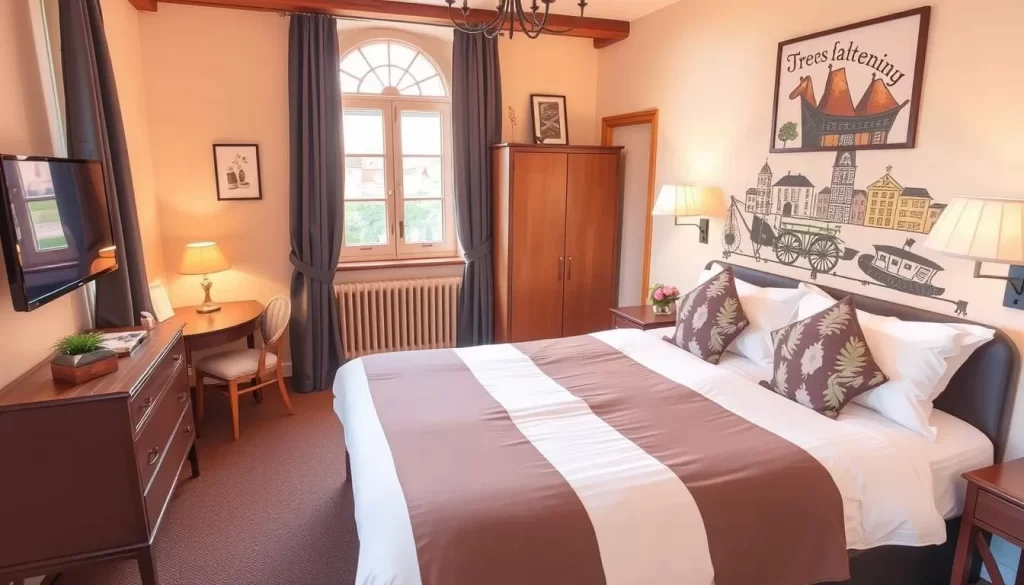
Accommodation in the City Center
Staying in the city center of Ypres puts you at the heart of the action, with many historical landmarks within walking distance. You can enjoy a comfortable night’s stay in hotels that offer modern amenities while being surrounded by the town’s historic charm.
Some top recommendations for city center accommodations include hotels near the Grote Markt, where you can enjoy views of the Cloth Hall or Menin Gate. These hotels often feature rooms with unique decor, adding to the overall experience of your stay.
Unique and Boutique Hotels
For a more distinctive experience, consider staying at one of Ypres’ unique or boutique hotels. For instance, the Main Street Hotel is known for its creatively themed rooms, each offering a different theme and personalized touches that make your stay truly memorable.
- Discover distinctive accommodations like the Main Street Hotel, where each room features a different creative theme and personalized touches.
- Learn about historic properties that have been converted into boutique hotels, offering a blend of modern comfort and period charm.
- Explore unique options like Kasteelhof ‘t Hooghe, a castle-hotel located near a former battlefield site.
- Find special accommodations that offer memorable experiences, such as rooms with views of the Cloth Hall or Menin Gate.
- Get recommendations for romantic getaways and special occasion stays that go beyond the typical hotel experience.
Culinary Delights: Where to Eat in Ypres
When you’re not exploring the historical sites of Ypres, you’ll find a variety of delicious dining options to satisfy your cravings. The city offers a range of culinary experiences, from traditional Belgian cuisine to modern eateries and charming cafes.
Traditional Belgian Cuisine
Ypres is a great place to try authentic Belgian dishes. A L’Envers is highly recommended for its traditional Flemish cuisine with a modern twist. Their pork cheek stew is a must-try, and be sure to leave room for their creme brulee. Reservations are recommended as it’s a popular spot.
For a more casual dining experience, the area around the Grote Markt offers several options where you can enjoy Belgian classics while people-watching. You can also visit Brood Henk Banket, an amazing bakery with a wide range of bread, pastries, and cakes. Their custard-filled croissants and chocolate eclairs are particularly delightful.
Top-Rated Restaurants and Cafés
In addition to traditional Belgian cuisine, Ypres is home to a variety of top-rated restaurants and cafes. St Arnoldus is a specialty beer cafe with a large selection of local Belgian beers on tap, accompanied by Flemish bar snacks. It’s a great spot to sample some of Belgium’s renowned beers.
For those with a sweet tooth, Peter De Groote is the place to go for the finest Belgian chocolates. They offer many boxed selections and a large display of various chocolate assortments to pick and mix. It’s a perfect spot to indulge or pick up some gifts.
Other charming cafes like De Ruyffelaer and ‘t Klein Stadhuis are perfect for coffee, pastries, and light lunches during a day of sightseeing. These spots offer a cozy atmosphere where you can relax and enjoy local flavors.
Whether you’re looking for a family-friendly restaurant or a place that accommodates dietary restrictions, Ypres has a variety of options to suit your needs. Enjoy exploring the culinary delights this historic city has to offer during your day trip or longer stay in the area, which is known for its significant place in the world history, and discover the many shops that offer local specialties.
Belgian Specialties to Try in Ypres
Belgium’s culinary scene is renowned worldwide, and Ypres is no exception, offering a plenty of local treats. As you explore this historic city, you’ll have the opportunity to indulge in a variety of traditional Belgian cuisine that reflects the country’s rich culinary heritage.
Chocolates and Sweet Treats
Belgian chocolates are famous across the world, and Ypres is a great place to sample these delicious treats. You’ll find numerous chocolatiers and shops offering a wide range of handcrafted chocolates. From classic pralines to innovative flavor combinations, there’s something to satisfy every chocolate lover’s cravings. Be sure to try some of the local specialties like waffles and speculoos (spiced cookies), which are perfect accompaniments to a cup of coffee or tea.
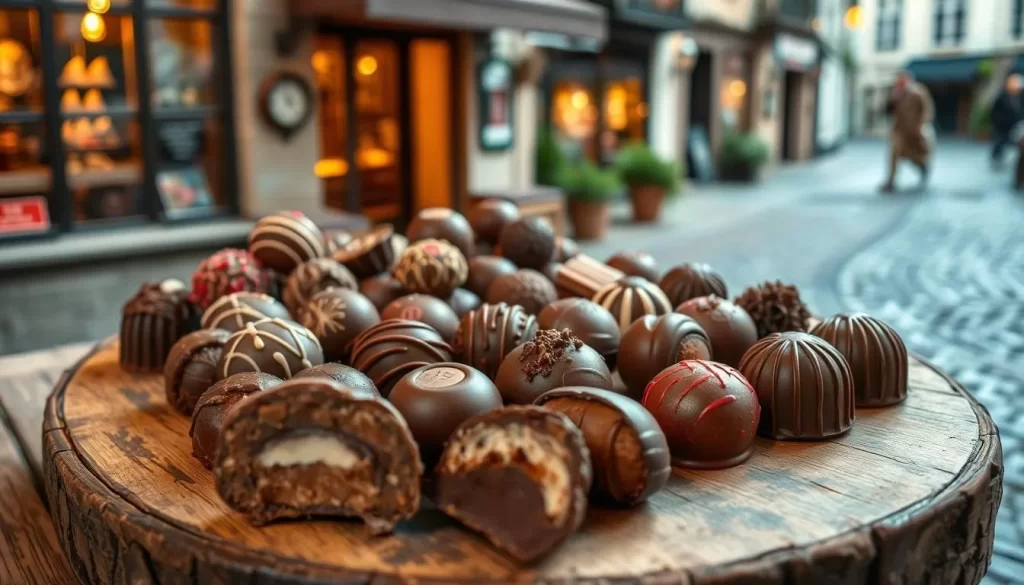
Belgian Beers and Local Specialties
Belgium is celebrated for its beer culture, recognized by UNESCO as intangible cultural heritage. In Ypres, you can experience this rich brewing tradition firsthand. Visit St. Arnoldus, a specialty beer café that boasts an impressive selection of local Belgian beers on tap, along with traditional Flemish bar snacks. You can discover a variety of beers, from Trappist ales to lambics, witbiers, and strong Flemish reds, showcasing the diversity of Belgian brewing. The knowledgeable staff at St. Arnoldus can guide you through tasting flights and help you pair your beer with local delicacies like cheese cubes, mustard, and bitterballen, enhancing your appreciation for the country‘s beer-making expertise.
- Explore the variety of Belgian beers available in Ypres, including seasonal and limited-edition brews.
- Learn about local breweries in the region and their signature beers.
- Enjoy traditional Flemish bar snacks that complement your beer perfectly.
Getting to and Around Ypres
Getting to Ypres is straightforward, with multiple options available for travelers. Ypres, a significant historical site in Flanders, Belgium, is easily accessible by car, train, or even on foot once you’re in the area. Understanding your transportation options is key to enjoying your visit to this historic city.
Transportation Options
Ypres is well-connected by train, making it an ideal destination without needing a car. The nearest airports are Brussels and Antwerp, from which you can take a train to Ypres. Trains are an efficient and affordable way to get around Belgium and many surrounding countries. If you prefer to drive, Ypres is accessible by car via major highways. Once in Ypres, the city is compact, and many sights are within walking distance, making it easy to explore on foot or by bike.
| Mode of Transport | Nearest Hubs | Advantages |
|---|---|---|
| Train | Brussels, Antwerp Airports | Efficient, Affordable |
| Car | Major Highways | Flexibility, Scenic Routes |
| On Foot/Bike | Within Ypres City | Exploratory, Environmentally Friendly |
Day Trips from Ypres
One of the advantages of visiting Ypres is its strategic location for exploring the surrounding area. You can easily take day trips to nearby destinations. For history buffs, a visit to the Poperinge, known for its hop fields and Talbot House, is just a 15-minute train ride away. You can also explore the historic city of Lille, France, accessible in under an hour by car or train, making for a great cross-border day trip. The beautiful medieval city of Bruges is reachable in about an hour by car or 90 minutes by train, offering a glimpse into Belgium’s rich medieval past.
- Discover Poperinge’s hop fields and Talbot House
- Explore Lille, France, for a cross-border experience
- Visit the medieval city of Bruges
- Enjoy coastal excursions to De Panne and Ostend
- Take a self-drive tour of the Flanders Fields area
By planning your day trips, you can experience the best of what the region has to offer, from historical sites to natural beauty, all within a day’s journey from Ypres.
Conclusion: Making the Most of Your Visit to Ypres
With its unique blend of history, culture, and small-town charm, Ypres is a place that will captivate you long after your visit. As you plan your trip to this poignant Belgian town, you’ll discover that Ypres offers a rich tapestry of experiences that cater to all interests.Essential Experiences in Ypres
Your visit to Ypres should include the In Flanders Fields Museum, where you can delve into the history of World War I through interactive exhibits. The Last Post Ceremony at the Menin Gate Memorial is another must-experience, a poignant tribute to the soldiers who lost their lives. Exploring the battlefield sites and war cemeteries in the area will provide a deeper understanding of the historical significance of Ypres.
For history buffs, Ypres is a treasure trove. The town’s historical significance is palpable as you walk through the streets and visit sites like the Menin Gate Memorial and Tyne Cot Cemetery. Families will also find plenty to enjoy, from the Bellewaerde Theme Park to interactive museums and kid-friendly attractions.
Practical Tips for Your Visit
To make the most of your day or days in Ypres, consider the following itineraries: For a 1-day visit, focus on the central attractions like the Grote Markt and the In Flanders Fields Museum. A 2-day itinerary allows you to explore the surrounding battlefield sites and war cemeteries. If you have 3 days, you can delve deeper into the local culture, visit lesser-known historical sites, and enjoy the local cuisine.
When visiting war memorials and cemeteries, it’s essential to approach these sites with respect and reflection. The Tourism Ieper office, located in the Cloth Hall at Grote Markt 34, 8900 Ieper, is a valuable resource for personalized assistance and the latest event information. You can contact them at +32 (0)57 23 92 20 or [info@toerismeieper.be](mailto:info@toerismeieper.be).
Ypres is a living, evolving town that offers something for every type of traveler. Whether you’re drawn to its historical aspects, its contemporary charm, or simply looking to experience Belgian culture, Ypres is a destination that will leave a lasting impression. As you plan your visit, you’re not just preparing for a trip; you’re embarking on a journey through history, culture, and the heart of Flanders.
